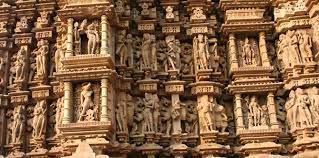Q. How will you explain that Medieval Indian temple sculptures represent the social life of those days?
Ans: Medieval Indian temple sculptures provide valuable insights into the social life and cultural context of that era. These sculptures serve as a visual record that helps us understand various aspects of society during the medieval period in India, roughly spanning from the 6th to the 16th century.

- Depiction of Daily Life: Many temple sculptures depict scenes from everyday life, showcasing activities such as farming, trade, music, dance, cooking, and various forms of craftsmanship. These representations give us a glimpse into the occupations, routines, and interactions of people from different social strata.
- Cultural Practices and Beliefs: Temple sculptures often illustrate religious rituals, ceremonies, and mythological narratives. These artworks reflect the religious and spiritual beliefs of the time, shedding light on how people practiced and interpreted their faith. The depictions of deities, saints, and mythological figures provide insight into the prevalent religious and philosophical ideologies.
- Socioeconomic Hierarchies: The sculptures often portray kings, nobles, and commoners engaged in different activities. This differentiation in the portrayal of individuals can provide clues about social hierarchies, class distinctions, and the roles people played within the society.
- Gender Roles and Relationships: Temple sculptures can also reveal information about gender roles, familial relationships, and societal norms related to men and women. Depictions of families, couples, and interactions between genders offer glimpses into how these relationships were perceived and valued.
- Architectural and Artistic Styles: The architectural and artistic details of temple sculptures showcase the craftsmanship, skills, and aesthetic preferences of the time. These sculptures often exhibit distinct regional styles and influences, reflecting the cultural diversity and exchanges prevalent during that era.
- Education and Learning: Some temple sculptures depict scenes of learning, including scholars, teachers, and students engaged in discussions. These representations provide insights into the educational systems and intellectual pursuits of the medieval period.
- Trade and Interaction: Scenes of trade, travel, and interaction between different communities and regions can be found in temple sculptures. These depictions offer clues about the economic activities, trade routes, and cultural exchanges that shaped the society.
- Social Values and Norms: The narratives and symbolism present in temple sculptures can offer insights into the prevailing social values, moral teachings, and ethical principles of the time. These artworks often convey messages about virtues, dharma (righteousness), and societal codes.
It’s important to note that while temple sculptures provide a window into medieval Indian society, interpretations can vary.
Than for reading article on How will you explain that Medieval Indian temple sculptures represent the social life of those days?
UPSC CSE 2022 Mains GS 1 Paper Model Answer